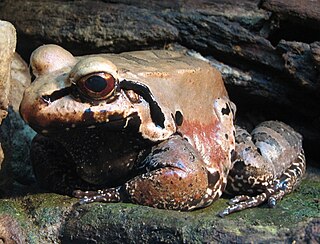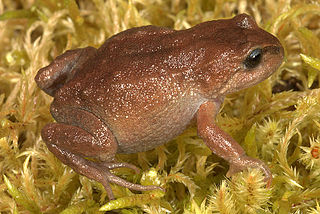
Phrynopus is a genus of frogs of the family Strabomantidae. Their common name is Andes frogs. They are endemic to Peru and inhabit the upper humid montane forest and supra-treeline grassland in the Cordillera Oriental, with one record from the Peruvian Cordillera Occidental.
Rulyrana spiculata is a species of frog in the family Centrolenidae. It is endemic to the eastern slopes of Andes in central and southern Peru and northern Bolivia. Common name Cuzco Cochran frog has been coined for it.
Pristimantis eremitus is a species of frog in the family Strabomantidae. It is found in the Cordillera Occidental in north-western Ecuador from the Cotopaxi Province northward and on western slope of the Colombian Massif in the Nariño Department, extreme south-western Colombia. The specific name eremitus is Latin for "lonely" or "solitary" and refers to this species being the only western-Andean species among its closest relatives. Common names Chiriboga robber frog and lonely rainfrog have been coined for it.

Pristimantis leptolophus is a species of frog in the family Strabomantidae. It is endemic to Colombia and known from the páramos of the Colombian Massif and Cordillera Central in the departments of Cauca and Huila. The specific name leptolophus is derived from Greek leptos ("thin") and lophos ("crest") and refers to the low dorsolateral folds of this frog. Common name volcano robber frog has been coined for it.
Pristimantis salaputium is a species of frog in the family Strabomantidae. It is endemic to Peru and known from its type locality, the Río Cosñipata Valley, on the northeastern slopes of the Cadena de Paucartambo, a frontal range of the Cordillera Oriental in Cusco Region, and from the Apurímac River valley. Its range might extend into Bolivia. The specific name salaputium is Latin meaning "dwarf" and refers to the small size of this species. Common name river robber frog has been coined for it.

Gastrotheca excubitor is a species of frog in the family Hemiphractidae. It is endemic to southern Peru and occurs in the Amazonian slopes and crests of the Cordillera Oriental in the Cusco Region; records from the Cajamarca Region are likely erroneous. It is likely to include cryptic species. Common name Abra Acanacu marsupial frog has been coined for it.

The smoky jungle frog is a species of frog in the family Leptodactylidae. It is found in Bolivia, Brazil, Colombia, Ecuador, Costa Rica, Panama, French Guiana, and Peru. Its natural habitats are tropical and subtropical moist broadleaf forests, subtropical or tropical swamps, subtropical or tropical moist montane forest, rivers, freshwater marshes, intermittent freshwater marshes, and aquaculture ponds.
Psychrophrynella bagrecito is a species of frog in the family Strabomantidae. It is endemic to the Cusco Region, Peru, and found on the Amazonian slopes of the Andes at elevations of 1,830–2,740 m (6,000–8,990 ft) asl. The specific name bagrecito is Spanish meaning a small catfish, and a nickname for David C. Cannatella, a colleague of John D. Lynch, the scientist who described the species from specimens collected from near Marcapata.

Bryophryne cophites, also known as the Cusco Andes frog or the Cuzco Andes frog, is a species of frog in the family Strabomantidae. It is endemic to Peru and known only from slopes of the Abra Acanacu in the Cordillera de Paucartambo, Cusco Region. There is an unconfirmed record from a neighboring mountain range, so this species might be more widespread than current knowledge suggests.
Niceforonia lucida is a species of frog in the family Strabomantidae. It is endemic to Peru and known from the Cordillera Central west of the Apurímac River in the Ayacucho Region. Common name Cannatella's Andes frog has been coined for it. The specific name lucida refers to distinctive coloration of this frog relative to frogs in the genus Phrynopus, the genus where this species was initially placed. However, later studies have moved it to other genera where its colors are less distinctive.
Phrynopus montium is a species of frog in the family Strabomantidae. It is endemic to Peru and only known from two localities near Cascas in the Junín Region: "Cascas near Huasahuasi", the imprecisely known type locality where the types were collected in 1936, and south of Hacienda Cascas, where it was found in 2014. Records from the PascoPasco and Huánuco Regions refer to Phrynopus kotosh and Phrynopus oblivius, respectively. Common name Cascas Andes frog has been coined for this species.
Lynchius nebulanastes is a species of frog in the family Strabomantidae. It is endemic to north-western Peru where it is known from the vicinity of its type locality, El Tambo, on the western slope of the Cordillera de Huancabamba, Piura Region. Common name Canchaque Andes frog has been coined for it.
Noblella myrmecoides is a species of frog in the family Strabomantidae. It is found in the upper Amazon Basin of southeastern Colombia, eastern Ecuador, eastern Peru, Bolivia, and western Brazil (Amazonas). Common name Loreto leaf frog has been coined for this species.

Bryophryne is a genus of frogs in the family Strabomantidae. These frogs are endemic to south-eastern Peru in the Cusco Region, with an undescribed species from the Puno Region. Their range is separated from that of Phrynopus by the Apurímac River valley.

Psychrophrynella is a genus of frogs in the family Strabomantidae The genus is distributed on the Andes of southern Peru and Bolivia. One of the four species assessed by the International Union for Conservation of Nature (IUCN) is assessed as "Critically Endangered".

Noblella madreselva is a species of frog in the family Strabomantidae. The species is only known from its type locality, Madre Selva in the La Convención Province, Cusco, Peru.

Psychrophrynella usurpator is a species of frogs in the family Strabomantidae. It is endemic to Peru and known from near Abra Acjanacu, a mountain pass in the Cordillera de Paucartambo, the easternmost Andean range towards the Amazonian lowlands, and from the high elevation grasslands of the Manu National Park. It is named usurpator because these frogs were previously misidentified as Noblella peruviana—in a sense, they had "usurped" the name of another frog species.

Pristimantis attenboroughi, also known as Attenborough's rubber frog, is a species of frog in the family Strabomantidae. It is endemic to the Peruvian Andes and has been recorded in and near the Pui–Pui Protection Forest. It is the first amphibian named after David Attenborough. It was discovered by Edgar Lehr and Rudolf von May during a period of two years of studying the forests of Peru. The species description was based on 34 specimens caught at elevations of 3,400–3,936 m (11,155–12,913 ft) above sea level.
Noblella thiuni is a species of frog in Peru. It is 11 millimetres in length placing it as one of the smallest amphibians in the world. It lives in the leaf litter of a montane forest making it difficult to spot. This minute frog has the dorsum tan with a dark brown X-shaped middorsal mark and dark brown markings, the chest and belly copper reddish with a profusion of silvery spots, the ventral surfaces of legs bright red, and the throat and palmar and plantar surfaces brown. The species was discovered in 2017 near Thiuni, in the Provice of Carabaya, Department of Puno, in the upper watershed of a tributary of the Inambari River, Peru, and is known only from a single specimen.
Telmatobius mantaro is a species of frog in the family Telmatobiidae. It is endemic to the eastern Cordillera Central of the Peruvian Andes. The specific name mantaro refers to the Mantaro River running near the type locality.











